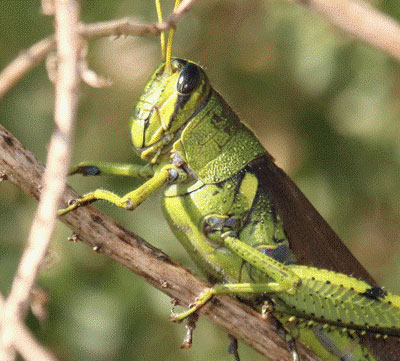It is well understood that weather patterns can have a significant impact on grasshopper populations year to year. Warm, dry weather increases the survival of nymphs and adult grasshoppers, leading to increased egg production during the growing season, while cool, wet weather promotes fungal pathogens that can reduce egg and nymph survival. The abundance of grasshoppers being observed now is likely due to the weather patterns of the last couple seasons. Another factor influencing grasshopper populations is an abundance of food, especially broadleaf weeds. A diet high in these forbs leads to greater nymph survival, faster growth, larger adult grasshoppers, and increased egg production. Despite many areas still being impacted by some level of drought, sporadic rainfall over the growing season has helped weeds persist in many areas of the state, which has likely contributed to the noticeable number and diversity of grasshoppers currently being observed. As these weedy sources of food are exhausted or controlled, grasshoppers may shift their grazing over to anything still growing in the landscape. In areas with greater grasshopper pressure, seedling alfalfa and wheat could be at risk.

Figure 1. Adult grasshopper. Photo by Anthony Zukoff, K-State Research and Extension.
Before planting alfalfa, treatment should be considered if there are 15 or more grasshoppers per square yard around the planting area. Once planted and growing, consider treatment if 3-5 grasshoppers per square yard are found in the seedling alfalfa stand.
Vegetated borders around areas where wheat will be planted should be scouted ten days before planting. Consider treating those borders if there are 7 to 12 grasshoppers per square yard. Once growing, three or more grasshoppers per square yard within the field can destroy seedling wheat stands. If grasshopper populations are low to moderate, seed treatments can protect emerging wheat plants for several weeks if products are applied at the highest registered rate. Seed treatments will be less effective under severe grasshopper pressure as the insects can consume a large amount of leaf material before succumbing to the seed treatments. It is advisable to avoid planting too early, as this will help reduce the time that wheat must be protected.
Please refer to the most recent Alfalfa and Wheat Insect Management Guides for specific control information.
Alfalfa Insect Management Guide https://bookstore.ksre.ksu.edu/pubs/MF809.pdf
Wheat Insect Management Guide https://bookstore.ksre.ksu.edu/pubs/MF745.pdf
Anthony Zukoff, Extension Entomology Associate – Garden City
azukoff@ksu.edu
Tags: wheat alfalfa insects grasshoppers